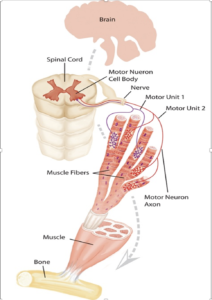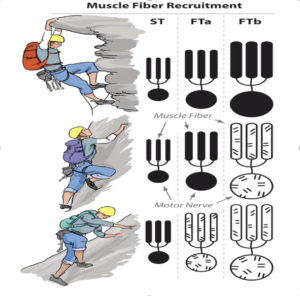All muscle fibers are not created equal. That’s a lucky thing. Some are needed to lift heavy things and for sprinting. These we call Fast Twitch (FT). Others are best for running marathons. Those we call Slow Twitch (ST). They both have special characteristics that endow them with qualities of either strength or endurance. Each of us has our own unique mixture of FT and ST muscle fibers. The proportion of each type makes some of us better weight lifters and sprinters and others of us better at running marathons. There are different approaches to training that better suit either Fast Twitch (FT) or Slow Twitch (ST) muscle fiber-type dominant athletes. This article will help you understand muscle fiber types, determine which category you fall into, and how that knowledge impacts your training decisions. I’ve coached both types of athletes to excellent results and have learned a few things along the way that I’ll share.
Individualization of Training prescription is essential for any athlete to reach their potential. Plugging into a program that worked for a friend or for Kilian Jornet is just a hit-or-miss approach. It is why we have developed our simple tests to determine two significant metabolic events that help you gauge your response to endurance exercise. These are not the only ways to assess your phenotype, but along with training history, they’ll give you an individualized starting point. Another valuable bit of information to help you understand the best approach to your Training is determining your Muscle Fiber Type.
As athletes and coaches, we don’t need to get into the science weeds on fiber types to give us an excellent model to work from. However, having a solid layperson’s understanding will help you.
I need to introduce the term Motor Unit into this discussion to help illuminate how muscle fibers are recruited to propel you. A motor unit (MU) is a group of muscle fibers with similar characteristics AND the motor nerve that enervates them. When that nerve gets its signal from the motor cortex part of the brain, all the fibers connected to it contract in unison. A remote feedback system involving tiny proprioceptors near the junction of muscle and tendon called Golgi tendon organs modulates the muscle forces based on the stretch in the tendon. This feedback and resultant force modulation are what control your movement.
Jump Ahead To:
ToggleFast Twitch Motor Units
Some MUs are called FT. These contract rapidly with a great deal of force. The FT muscle fibers in these MUs are thicker in cross-section and not well endowed with endurance characteristics. The signal to fire the MU comes through the connected motor nerve. It takes a powerful nerve signal to get the FT MU to fire and the attached muscle fibers to contract. FT fibers have what is called a high action potential. You have to want to call these higher-force FT fibers into the game. These require real effort to engage. Think of lifting a heavy weight or sprinting. You won’t do either of those very well without concerted effort and focus
Slow Twitch Motor Units
This type of MU is the polar opposite of their FT neighbors. The ST muscle fibers are smaller in cross-section, endowed with more endurance, and have a lower action potential. That lower action potential is why you can walk and chew gum simultaneously without perceptible exertion.
The Muscle Fiber Type Continuum
In the real world, fibers and their MUs are not separable into these two back-and-white categories. They exist along a continuum from the slowest ST fibers on one end of that scale to the fastest (most forceful) FT fibers on the other end. In between are fibers with a varying mixture of ST and FT characteristics. Exercise scientists have divided these intermediate fibers into artificial groupings based on those characteristics, FTa being the most endurance-endowed and least forceful, FTb being the most forceful with poor endurance. There are more subgroups, but we won’t concern ourselves with those distinctions because they’re not crucial to this discussion. They require a muscle biopsy (taking a small but painful core sample out of the muscle) to determine.
We need to know that the FT MUs are more forceful, have less endurance, and have a higher action potential than the ST MUs.
What Type of Athlete Are You?
Let’s now talk about how to determine if you have a muscle fiber type that is dominant. We’ll start with the simplest ways and work toward more elaborate methods.
- At recess in grade school, were you the kid everyone wanted to be on their team?
- Did you excel at ball sports and could out-sprint older kids?
- Do you tend to put on muscle mass relatively quickly?
- Did you dunk the basketball or even touch the net in high school?
- Can you produce very high (>15mMol/L) blood lactate in a 30-second all-out effort?
- Can you single-leg hop 25 meters in 10 hops (male) or 11 hops (female)?
- Is your standing broad jump greater than your body height?
If any of these apply to you, there is an excellent chance your muscle fiber composition leans toward Fast Twitch.
- Were you always picked last for the ball sports teams in school?
- Are you relatively lightly muscled and struggle to gain muscle mass?
- Can you only dream of being able to dunk a basketball or even touch the net?
- When your blood lactate level hits 7mMol/L, do you feel like you are about to die?
- Can you barely cover 1 meter when you do a single leg hop?
- Is your standing broad jump less than your body height?
If these apply to you, there’s a good chance that you are Slow Twitch dominant.
There’s an old saying among track coaches:
“Sprinters are born. Distance runners are made.”
Training Implications
I have read several anecdotal reports by coaches who spent a lot of effort and time fruitlessly trying to increase the anaerobic capacity of a ST athlete. The message contained in the simple sentence above belies a fundamental truth. Besides the innate genetic predisposition, training history impacts fiber type proportion and distribution. It has long been known from rodent studies that mice will change their fiber type composition to become more ST-dominant with a high volume of endurance training. Heikki Rusko performed the earliest human longitudinal study in the 1980s, following high-level Finnish junior cross-country skiers throughout their careers. As they accumulated more volume of endurance training, their fiber composition became more ST predominant. In the past 20 years, several more longitudinal studies have shown the same effect of endurance training converting FT fibers to ST. The fiber composition shifts toward FT when endurance training is reduced or stops.
I am unaware of studies showing that training more speed and power will shift the fiber type composition toward the FT end of the scale. That does not mean it can’t happen, but It would be challenging to increase the anaerobic power of endurance athletes. Perhaps there is real wisdom in the quote at the beginning of the section.
On the other hand, I’ve had good luck improving FT athletes’ endurance. There are some pretty simple rules to keep in mind. Be aware of these differences in the approach to training these groups. The following summaries should help.
Fast Twitch Athletes
- They have low aerobic capacity meaning they use more anaerobic energy even at low intensities. Require more easy aerobic base training or recovery will be a problem.
- Have high anaerobic capacity and power. This is a real benefit for a late-stage kick in a race if the athlete has not had to use it to maintain the pace. The FT athlete needs to conserve this “secret weapon” that ST athletes can only dream of.
- Recovery workout must be super easy to ensure FT fibers/Anaerobic metabolism is not engaged.
- It takes more high-intensity training to reach peak form.
- Must be careful with high-intensity (Z3-4) aerobic/anaerobic endurance training. Best to use short work reps in interval sessions with standing/slow walking longer recovery to ensure lactate gets shuttled. E.g., 10x2min with 3min standing or slow walking recovery rather than 4x5min with 2 min active recovery for Z4 session.
- Run higher lactate levels due to poor shuttle and less ability to use lactate as fuel.
- More reliance on FT fibers and anaerobic metabolism so lactate a bigger problem.
- The FT athlete must focus on Z1-2 aerobic base work to shift fiber type and improve aerobic capacity.
Slow Twitch Athletes
- Have low anaerobic capacity, so they are less able to kick at the end of a race.
- Handle faster, easy runs better. They are using ST fibers at higher intensities. Do not let ST and FT athletes do aerobic base training together, even if race times are the same.
- It takes less high-intensity training to reach peak form.
- Can handle active recovery during rest intervals in high-intensity sessions due to better lactate clearance.
- Handle long reps in interval sessions and tempo runs better.
- Have to be careful not to overdo intensity with ST athletes. Because they have a high work capacity, they will feel like they can handle more intensity, but pushing them into overreaching and overtraining is easy.
- A little intensity goes a long way.
Interval Training Fundamentals
Let’s set the record straight: “interval” refers to the REST interval between the work bouts. It does not refer to the work period. Ok, I got that off my chest.
Interval training was developed and refined in Germany in the 1930s by Waldemar Gershler and Hans Reindell to improve running performance. They believed that the main benefits accrued during the rest interval as the heart rate declined faster than the rate at which blood returned to the heart. This effect causes a transient increase in the stroke volume, which overloads the heart, effectively making it stronger and increasing its pumping capacity. Because there are many recovery intervals in an interval workout, the stimulus to increase the heart’s stroke volume occurs many times. This gave a better stimulus to the heart than one long steady state work period, completed at a lower heart rate.
In the 1970s, one of the giants of exercise science, Per-Olaf Åstrand, wrote in his seminal volume: The Textbook of Work Physiology, that it was unknown if it was more beneficial to do more, shorter, higher intensity work periods in an interval workout or to do fewer, longer, lower intensity work periods. That question has still not been answered definitively to this day, which is why there are so many variations in interval training. It is probably also why many coaches continue to use methods they have found to work before and use variations of short and long work periods.
So there you have it. That’s the long and short of interval training.
I love rabbit holes, but this argument is not one I want to address in this article. Instead, I want to discuss the effects of different work-to-rest ratios used in interval training.
Guidelines for Interval Workout Design
While there is no doubt that interval training benefits the heart’s stroke volume and maxVO2, I want to address the training effects on the propelling muscles as those related to improving endurance.
Referring back to the motor fiber recruitment model introduced earlier, we must target (recruit) the desired muscle fibers to achieve the desired training effect from any training session. If you can’t recruit them, you can’t train them. Below are guidelines and explanations to give some guidance and understanding as to how to design workouts to get a particular effect.
Starting from the low-intensity end of the scale:
Slow Twitch (aerobic base)
These motor units have the lowest action potential and the most endurance. They require long-duration continuous sessions at intensities up to the aerobic threshold and do generally not need an interval training protocol. The exception to this would be for very FT athletes who can use an interval session of many (total time of 30-60 minutes) short 30-60sec reps with equal rest intervals to prevent the accumulation of lactate. With lower lactate, an ST athlete can handle long continuous sessions at faster speeds.
Mid-Range FTa fibers (up to AnT)
The money section for most endurance athletes, so it is long;
These motor units are the endurance engine, and they are also the endurance limiter. Fatigue in these fibers will cause you to slow sustained efforts longer than just a few minutes. Consequently, these FTa fibers get a lot of attention in endurance training for the many minutes to many hour types of events we focus on. We’re talking about Zone 3 intensity level. By definition, the top of this zone is the maximum intensity where the lactate production rate equals the lactate removal rate. As a result, these fibers need a duration at this intensity that is long enough to tax their endurance or fatigue limit. Training at this intensity has several names, the most common of which are: Tempo, Lactate Threshold, and Anaerobic Threshold. It can be done as a continuous effort or using the interval method—the choice as to which comes down to the individual athlete. The goal of this session is to expose those FTa fibers to enough work that they fatigue due to the volume at this intensity. The goal is not to increase intensity. That will only recruit faster twitch fibers which fatigue quicker, thus limiting the time at the appropriate intensity. This intensity should feel like you have another gear. A “controlled, fun” kind of hard. Not a “bent over, hands on knees, gasping” kind of hard. The total work time for a Zone 3 session is entirely up to the athlete’s fitness and, IMPORTANTLY, muscular endurance. You have achieved the session’s goal as soon as these fibers become fatigued and drop out of the recruitment pool. Local muscular fatigue will limit how much, or for how long, you can sustain this pace/effort. Once you can no longer hold the pace, you’ve cooked those limiting fibers and are relying on the next lower power tier of fibers. That’s why you are going slower. But those fibers already have sufficient endurance to handle longer duration. Your intention with this session should be to tax those endurance-limiting fibers, so there is no point in grinding along slowly in a deeply fatigued state. All you are going to do is delay recovery and compromise the training effect you were hoping for. In this session, a world-class athlete typically tops out at one hour of total work time. It could be 60 minutes continuous, but more typically is done as work periods of 15-20 minutes with relatively short rest intervals. The well-trained amateur may get good results from 30-45 minutes of work time broken into 10-15 minute segments. The beginner, older, and less well-trained may need to use 15 to 30 minutes split into 6-10 minute work periods due to lack of muscular endurance. If you are doing this workout correctly, short rests SHOULD be all that is needed because lactate levels will be moderate and lactate clearance rapid. 2-4 minutes should allow enough recovery. If you cannot repeat the same intensity in a subsequent repetition, you have either gone too hard or need more muscular endurance.
As mentioned in the books and other writings, Local muscular fatigue is the most significant limitation to endurance. It will respond well to this Zone 3 training because you are pushing up against your endurance limit in each repetition and holding it for many minutes. However, this type of training has a relatively high global fatigue cost. Even for the world-class and Olympic-level athletes I have coached, I prefer to precede this block of intensity with a Muscular Endurance base period to elevate that quality. When I do that, the athlete can handle more of this traditional Zone 3 intensity training, recover faster, and benefit more from it. See this article for more info.
High Range of FTa into FTb Fibers (Zone 4/above AnT)
While this range of fibers also has an endurance limit mainly due to local muscular fatigue, that limit is at a higher speed. Remember, these fibers exist along a continuum, and these artificial groupings are an artificial construct we are using as a model to help explain a concept, and are not an exact representation of the complexities of the real world.
Because these fibers have poor endurance, they fatigue faster than the lower tier of Zone 3 FTa fibers we discussed. They’re good for just a few minutes of work before they check out of the game and need to rest on the bench. These are the power level of fibers recruited in efforts that result in the athlete’s maxVO2, mainly the cardiac training effect. Consequently, Zone 4 intensity is called maxVO2 Training. Because these fibers fatigue quickly, an interval training protocol is used for this training. The typical work period for Z4 Training is from 30 seconds to 4-5minutes, with a rest period ranging from 30 seconds for a 30-30 workout (described in Training for the Uphill Athlete), to long enough to allow for the completion of the next work period at the same speed as the previous period.
A recent Norwegian study indicated that 8-minute work periods significantly improved max VO2. In my experience, even elite athletes will experience significant fatigue during this long repetition and slow down considerably after just one repetition at this effort level. In my mind, this indicates that what is known as the Slow Component of maxVO2 is the primary training stimulus. If you are training with the aim of increasing max VO2, that might be an acceptable way to go. The fatigue induced during that training will cause the athlete to move slower. If you are training to make the athlete faster (which, in my mind, should be the primary goal), this may not be the best approach.
For an elite athlete, 15-20 minutes of total work in one session is typical. Once again, local muscular fatigue will typically limit the overall work done in one of these sessions. Less well-trained athletes will adjust down from there. As a gauge of the total number of repetitions, if the athlete slows during a repetition, double the next rest interval. The workout is over if the athlete can’t maintain the previous speed. Continuing will result in unnecessary and costly global fatigue.
Zone 4 training gives a powerful muscular endurance training stimulus on its own but carries with it a big global fatigue load. Just as for the Zone 3 training, I have found having a period of focused muscular endurance training before launching into a traditional Zone 4 interval training gives good results. It allows the athlete to handle more, recover faster, and benefit more from the interval sessions.
Maximum Intensity Zone 5 FTb Fibers
There are several benefits gained from this sort of training. These fibers rely almost exclusively on anaerobic metabolism for energy and have very poor endurance ability, and can last for no more than 10-12 seconds. While some events like hard rock and mixed climbing, Cross Country skiing, and Skimo sprints can benefit from developing anaerobic endurance, the multi-hour events we typically deal with do not have such a need. Anaerobic Endurance training carries a substantial global fatigue load that limits the frequency and duration, which limits its usefulness in an endurance training program.
This global fatigue is why sprinters in track, swimming, and cycling train a much lower volume than distance athletes. If you plan to include anaerobic endurance training in your plan, the question you must weigh is: Is the benefit worth the cost? In nearly all cases, I would say no. This type of Training means going at maximum effort from 20-60 seconds (to exhaustion), resting for 1-2 minutes, and repeating to exhaustion (usually 4-6 repetitions). It is training the body to produce, tolerate and deal with high lactate levels. This situation should never occur for an athlete in a multi-hour event. It may have some mental benefit in a peaking period.
While this pool of motor units is rarely required in most multi-hour events, a distinct strength training effect (power is the correct term) should make this type of training part of every endurance athlete’s program. Even though it will represent less than 1% of the annual training, it can pay outsized dividends by improving stride length. These are the most forceful fibers in your motor unit recruitment pool. They are hard to recruit, especially for the ST-dominant athlete. The ST athlete will see the most benefit from this sort of training. This type of training is distinctly different from anaerobic endurance training, however.
The Hill Sprint workout we advocate in Training for the New Alpinism and Training for the Uphill Athlete books exemplifies this workout. This workout uses maximum effort steep uphill sprints of 10-12 seconds with very long rests (at least 3 minutes) between sprints. These fastest FT fibers are powered by stored ATP and another energy-storage molecule called Creatine Phosphate (CP). Those stores run out in a few seconds of maximum power exertion. Aerobic metabolism replenishes the ATP and CP during long rest intervals. Insufficient rest will mean that those fastest twitch fibers aren’t recruited, and the next tier down the force continuum gets called in instead. We recommend marking the top of the hill you are sprinting on. When you can no longer reach that mark, double the rest interval and try again. If you can’t reach the mark, the workout is over. You have exhausted those motor units and done what you intended. The sprint-trained FT athlete may reach this in 5-6 repetitions. The newbie ST athlete might be able to go for 12 and still not get tired. That’s because the ST athlete will have difficulty recruiting these FTb fibers. Since he is recruiting fibers with better endurance, they don’t become fatigued in 10-12 seconds, so they recover quicker. This is why this ST athlete will benefit most from this training. Think of this as the most sport-specific strength/power training for all mountain athletes.
Summary
We’ve covered the muscle fiber/motor unit continuum, albeit broken down into artificial groupings. We discussed the differences in Training of ST and FT athletes and wrapped it with a discussion of the range of training protocols that target the different muscle fiber type groups. A couple of overarching takeaways are:
- Understand your muscle fiber type so you can target your training appropriately
- Understand that to recruit and train increasingly faster twitch fibers means using increasingly shorter work periods separated by longer rest intervals.
Whew! Got it? I hope so.





 Facebook
Facebook

[…] When it comes to appropriate training for FT and ST athletes, I have written extensively about that here. […]
My brother suggested I may like this web site.
He was entirely right. This submit actually made my day.
You cann’t imagine simply how so much time I had spent
for this information! Thank you!
Welcome to Evoke Endurance. I’m glad you found us and hope you enjoy reading the information we have.
Scott